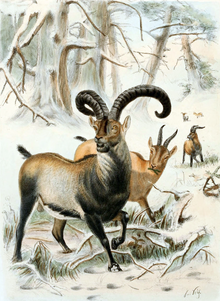| Pyrenean ibex | |
|---|---|

| |
| Illustration from 1898 | |
| Scientific classification | |
| Domain: | Eukaryota |
| Kingdom: | Animalia |
| Phylum: | Chordata |
| Class: | Mammalia |
| Order: | Artiodactyla |
| Family: | Bovidae |
| Subfamily: | Caprinae |
| Tribe: | Caprini |
| Genus: | Capra |
| Species: | |
| Subspecies: | †C. p. pyrenaica
|
| Trinomial name | |
| †Capra pyrenaica pyrenaica (Schinz, 1838)
| |

The Pyrenean ibex (Capra pyrenaica pyrenaica), Aragonese and Spanish common name bucardo, Basque common name bukardo, Catalan common name herc and French common name bouquetin, was one of the four subspecies of the Iberian ibex or Iberian wild goat, a species endemic to the Pyrenees. Pyrenean ibex were most common in the Cantabrian Mountains, Southern France, and the northern Pyrenees. This species was common during the Holocene and Upper Pleistocene, during which their morphology, primarily some skulls, of the Pyrenean ibex was found to be larger than other Capra subspecies in southwestern Europe from the same time.
In January 2000, the last Pyrenean ibex died, making the species extinct. Other subspecies have survived: the western Spanish or Gredos ibex and the southeastern Spanish or beceite ibex, while the Portuguese ibex had already become extinct. Since the last of the Pyrenean ibex became extinct before scientists could adequately analyze them, the taxonomy of this particular subspecies is controversial.
Following several failed attempts to revive the subspecies through cloning, a living specimen was born in July 2003. The cloned Pyrenean ibex was born in Spain through genetic cloning techniques, with the research article published in 2009.[2] However, she died several minutes after birth due to a lung defect.[3][4] The Pyrenean ibex remains the only animal to have ever been brought back from extinction—and also the only one to go extinct twice.
- ^ Herrero, J. & Pérez, J.M. (2008). "Capra pyrenaica subsp. pyrenaica". IUCN Red List of Threatened Species. 2008: e.T3798A10085397. doi:10.2305/IUCN.UK.2008.RLTS.T3798A10085397.en.
- ^ "Return of the Neanderthals". National Geographic Society. March 6, 2013.
- ^ Cite error: The named reference
r5was invoked but never defined (see the help page). - ^ Cite error: The named reference
Zimmerwas invoked but never defined (see the help page).